Bajra is an annual warm-season grass crop and it is also called Pearl millet, Cumbu. Bajra is an important crop in India. Like any grain crop, Bajra yields best on fertile, well-drained lands. Though, it also performs relatively well on sandy soils, in acidic soil conditions, and when available soil moisture and soil fertility are low. Bajra appears to have a relatively rapid growth of roots, which send wide roots underground and down to take advantage of available moisture and nutrients.
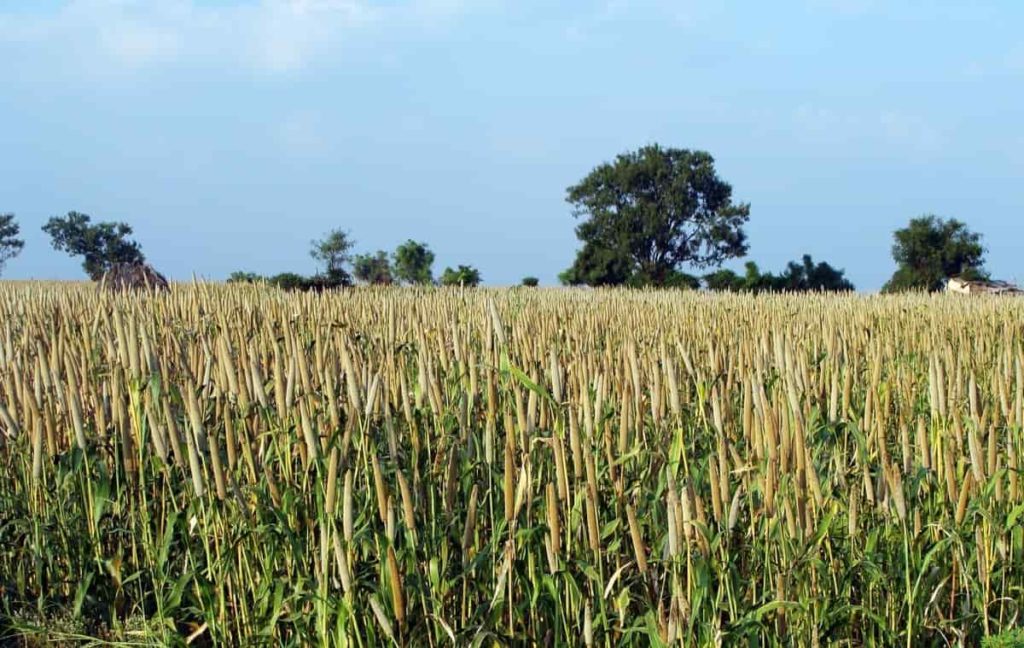
It is the most suitable fodder crop for arid areas. Fertilizer is also an important input in irrigated lands to increase crop productivity. Compared to other nutrients, nitrogen was found to affect the highest yield of Bajra. The best response of Bajra to nutrients was achieved when other harmonious factors were well adopted for maximum nutrient utilization. Let’s check out the best fertilizer for Bajra/Pearl millet.
Fertility management
Bajra will respond to good soil fertility, but it does not have a high demand for nutrients. About 40 to 80 pounds of nitrogen fertilizer per acre should be applied to most Indiana lands for conventional production. A small amount is appropriate if the millet follows a legume like Soybean. Since nitrogen requirements are modest, nitrogen fertilizer can be sidelined instead of pre-planted if appropriate.
Nitrogen requirements can certainly be met by organic sources, such as animal manure or legumes. The phosphorus and potassium rates can be applied recommended by the soil testing laboratory for millet. If P is tied close to the seed, the phosphorus reaction is likely to improve. Liming may not be necessary for Bajra on most Indiana lands, as it has been reported to be quite tolerant of low soil pH.
At the time of sowing, fertilizers are applied in split doses, half nitrogen, full phosphorus, and potash should be added. Organic manures should be applied 20 days before sowing for complete flowering. Apply a fourth dose of nitrogen approximately 30 days and 60 days after sowing.
Best fertilizer for Bajra/Pearl millet
Organic fertilizers
Application of organic manures such as FYM or fertilizer helps to increase crop yields at the rate of 150-200 quintals per hectare recommended for hybrid varieties under rainfed areas. The need for local varieties of Bajra fertilizer can be easily met by using 10-15 tons of compost or farmyard manure per hectare. But nutrition for hybrids and high-yielding varieties must be supplemented with inorganic fertilizers.
In case you miss this: Bajra Cultivation Income (Pearl Millet), Yield, Profit Guide
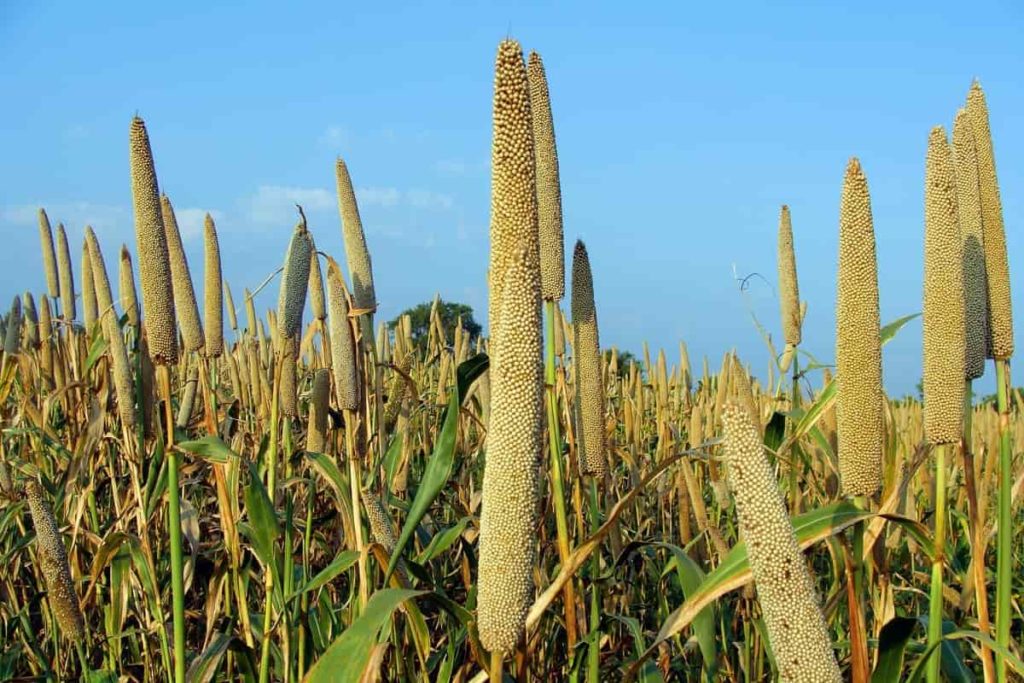
The use of organic manures such as well-decomposed FYM and compost, green manure, and green leaf manure methods provide nutrients. These nutrients are equally essential for Bajra plants for proper growth, development, and disease resistance. The use of 10-15 tons/ha of large organic manure improves the yield of Bajra as well as the productivity of the soil.
Best time to apply fertilizers
Apply the fertilizer at the time of planting the fertilizer and the rest after 3 to 4 weeks. Add potassium, phosphorus, and magnesium to the soil test as recommended for grain millet. Adding 10 to 15 pounds of sulfur per acre may be necessary to avoid deficiencies, especially in coastal plains. Because Bajra can grow well at lower ground pH than other cereal crops, it forms the basis for future crop needs (5.8-6.5).
Compost manure
Bajra responds well to farmyard manure and compost application. Apply 10 tons of farmyard manure or compost per acre one fortnight before sowing. Also, apply 25 kg urea at sowing time and 25 kg urea 25-30 days after sowing. In the absence of application of farmyard manure, it reuses 110 kg of urea per acre and this is in two split doses. Apply half of the urea at sowing time and the other half 25-30 days after sowing.
In case you miss this: Bajra Cultivation Information (Pearl Millet); Planting, Care
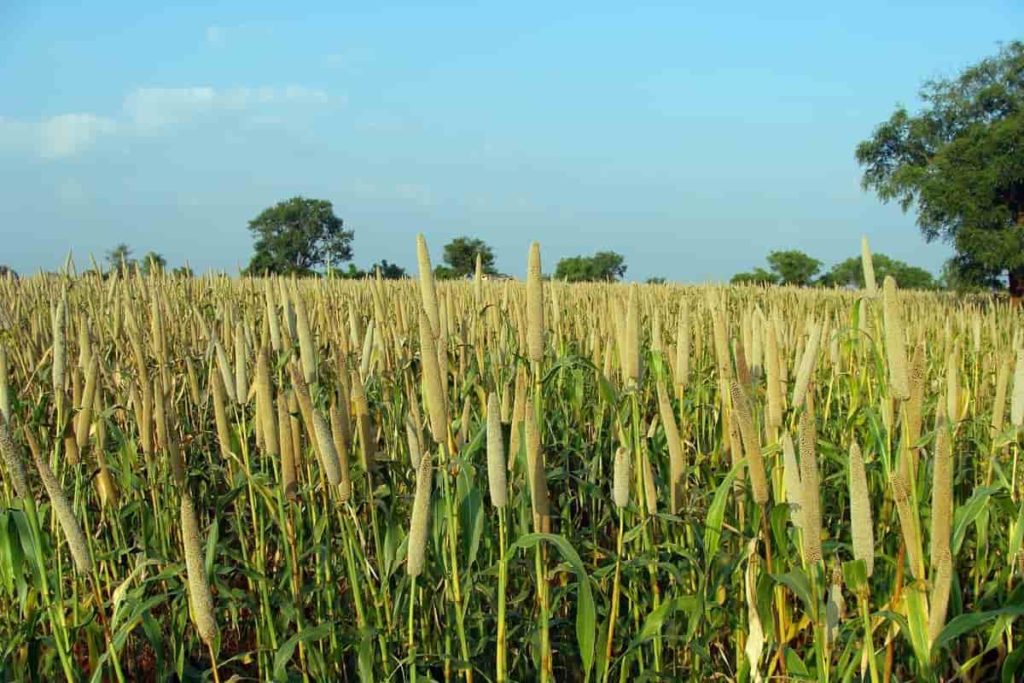
Method of fertilizer application
Open the furrow to a depth of more than 5 cm (1/3 distance from the bottom), add fertilizer, and cover for the transplanted crop. Mark the lines at a distance of 45 cm in the depth of more than 5 cm in the beds for the direct sown crop. Before sowing, place the fertilizer at a depth of 5 cm and cover up to 2 cm.
In case of intercropping with pulses, apply a depth of 30 cm in the beds no more than 5 cm. Apply fertilizer only in rows where Bajra is to be sown and cover up to 2 cm. When Azospirillum inoculant is used for seeds, use 60 kg N / ha for hybrids, and only 50 kg N / ha for seed variety in other words as soil use, reduce N to 25% in soil testing recommendations.
NPK fertilizer
Use balanced fertilizer according to the soil test basis. Generally, 80-100 kg nitrogen, 40-50 kg phosphorus, and 40 kg potash are recommended for hybrid varieties. While for composite varieties, 40-50 kg nitrogen, 25 kg phosphorus, and 25 kg potash per hectare are required.
Fertilizer requirement (kg / acre)
| Urea | DAP or SSP | |
| For loamy soil | 90 | 55 or 150 |
| For sandy soil | 55 | 27 or 75 |
For arid regions, application of 40 kg N + 20 kg P2O5 / ha and for semi-arid areas, 60 kg N / ha + 30 kg P2O5 / ha is recommended for sole Bajra as well as intercropping system. Nitrogen applied to light soils (sandy looms) can be lost due to leakage with heavy rainfall. At the time of seedbed preparation, only half of the nitrogen dose recommended should be applied. The other half of the nitrogen dose is side-dressed when the crop is 25 days old.
In case you miss this: District Wise Crop Production in Maharashtra: Major Crops in Maharashtra
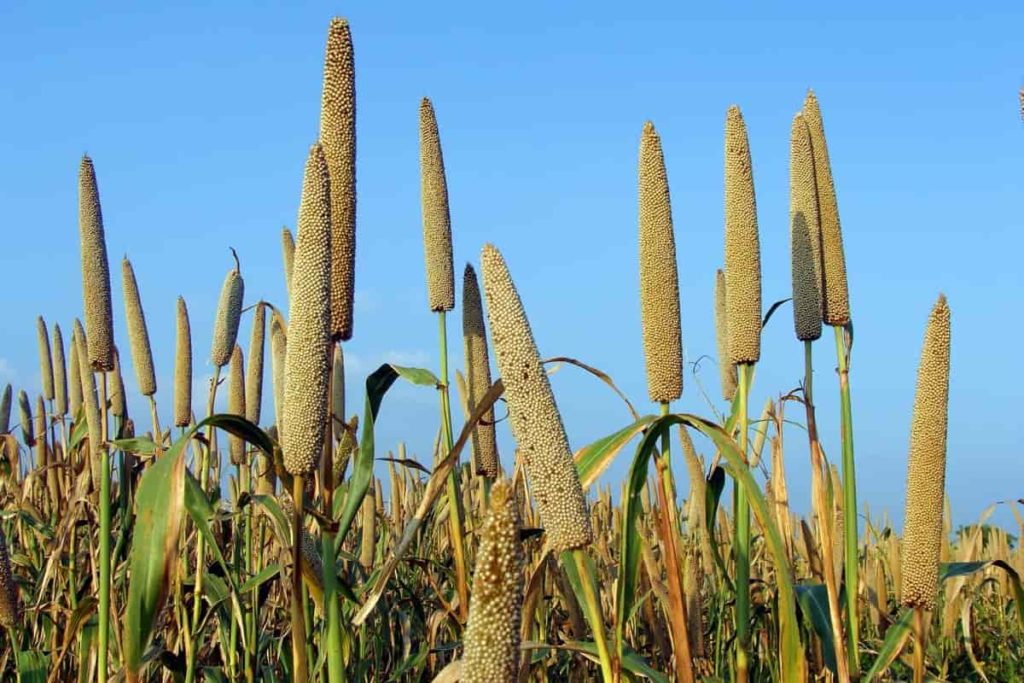
On soils that do not leach as easily as black soil, all nitrogen can be applied during seed preparation. Bajra seeds are sensitive to fertilizer burns. Remember that, do not apply fertilizer in the furrow with the seed or very near the seed in the row after sowing and it should be applied as a side dressing. The use of bio-fertilizers like Azospirillum and PSB can economize the use of N and P fertilizers. It is recommended to apply 10 kg ZnSO4 / ha in zinc-deficient lands of Bajra growing areas of the country.
A spray of 0.2% ZnSO4 is recommended to eliminate zinc deficiency in standing crops till sowing before the flowering stage. Under a long dry spell, skip the top dressing of nitrogen and then spray with 2% urea. During the vegetation phase in the Bajra crop, an additional dose of nitrogen by 20 kg/ha should be applied in case of excessive rainfall. At the time of sowing, a half dose of nitrogen and the full amount of phosphorus and potassium should be applied in furrows about 3-5 cm below the seed.
This can be done by applying fertilizer through a funnel and wherever seed-cum-fertilizer drill is not available, dropping the seed in the same furrow by hand. The remaining nitrogen is applied to the top-dresses in two splits, one at the time of thinning which means 3 to 4 weeks after sowing, and the rest at the stage of ear formation. This nitrogen dose can be stopped if the humidity is limited. Foliar spray of 3% urea is also recommended in rainy conditions.
Important nutrients for Bajra growth
Nitrogen Nutrition
- Nitrogen plays an important role in good growth.
- The availability of nitrogen for plants is indicated by the deep green color of stems and leaves and the full growth and development of Bajra.
- Nitrogen use is essential for acceptable production.
In case you miss this: Organic Farming In Karnataka, How To Start
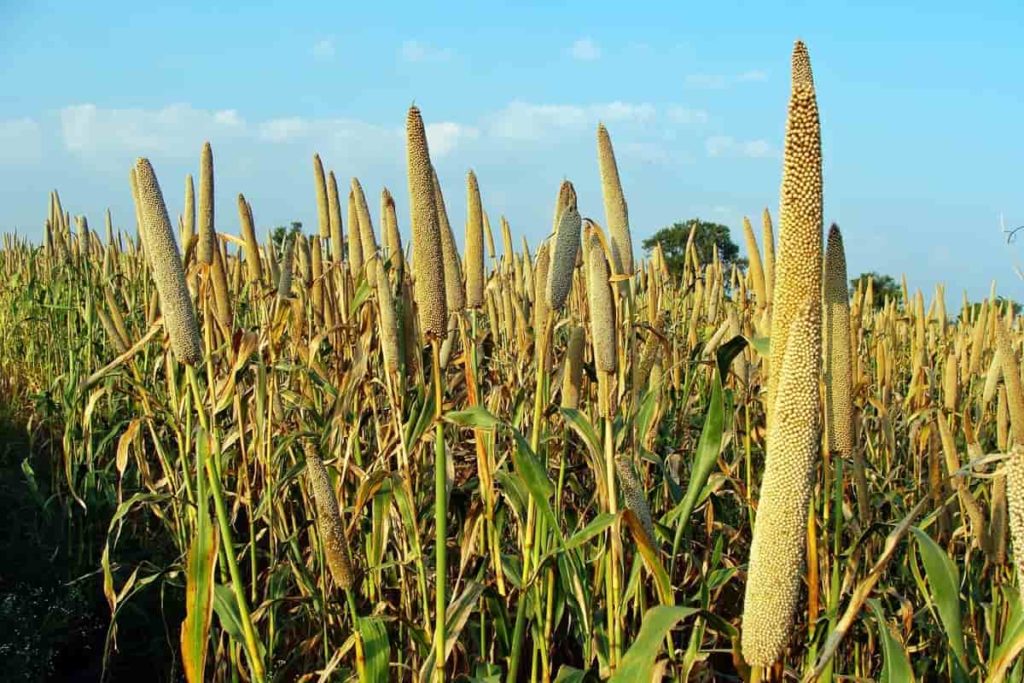
Phosphorus Nutrition
- Provide energy for the Bajra plant’s growth and development.
- Without phosphorus, Bajra plants cannot germinate even when nitrogen is abundant.
- It takes phosphorus from the planting stage to the grain filling stage.
- SSP is a good source of phosphorus requirement for permeability.
Potassium Nutrition
- Potassium content is higher in the early part of Bajra development than nitrogen and phosphorus. Therefore, potassium fertilizers are usually applied in one dose at the sowing time.
- In light soils, to reduce the loss of potassium due to leaching in heavy rainfall conditions, apply potassium in two divided doses. In such cases, top dressing is done 30 to 40 days after sowing.
- Potassium fertilizer with nitrogen and phosphorus is either applied to seed husks or side dressing before sowing. If required, potassium topped with the application of nitrogen.
- Fertilizers are applied near rows of Bajra plants and are added either by intercropping or by manure weeding. The soil should have sufficient moisture during this top dressing of fertilizer.
- Provides resistance to insects, diseases, and water pressure. Improves crop production quality.
- If the potassium available in the soil is less than 150 kg ha-1, then the recommended dose of potassium is the result of higher production in Bajra.
Micronutrients
Bajra responds well to micronutrients. The use of micronutrients increases grain production. Irrigated Bajra responds well to zinc up to 25 kg Zn So₄ / ha. Secondary nutrients and micronutrients play an important role in increasing the production of Bajra.
Nutritional deficiencies and their control
Nitrogen deficiency is usually the result of leaching damage due to inadequate fertilizer use, or excessive rainfall. Leaching usually occurs during high rainfall in sandy plain soils. Nitrogen is also lost through fluctuations in surface use during hot, dry weather.
Nitrogen deficiency symptoms
Small new growth, yellow leaves, it is more pronounced in old leaves and leaf drop. When the plants are planted, they move towards the base of light yellow or dark yellow color near the tips and margins, the heads are small, the number of seeds is less.
Control measure: Apply 8-10 kg N / acre as a top dressing or 2-3% urea foliar spray.
Phosphorus deficiency symptoms
Small root system; grain filling stopped. Growth stops dark green/purple leaves with dark red. Leaf-sheaths bend upwards with red leaves. The leaves are straight and leathery. The roots turn dark brown, purple, or black.
In case you miss this: Types of Millets In India, Cultivation FAQs
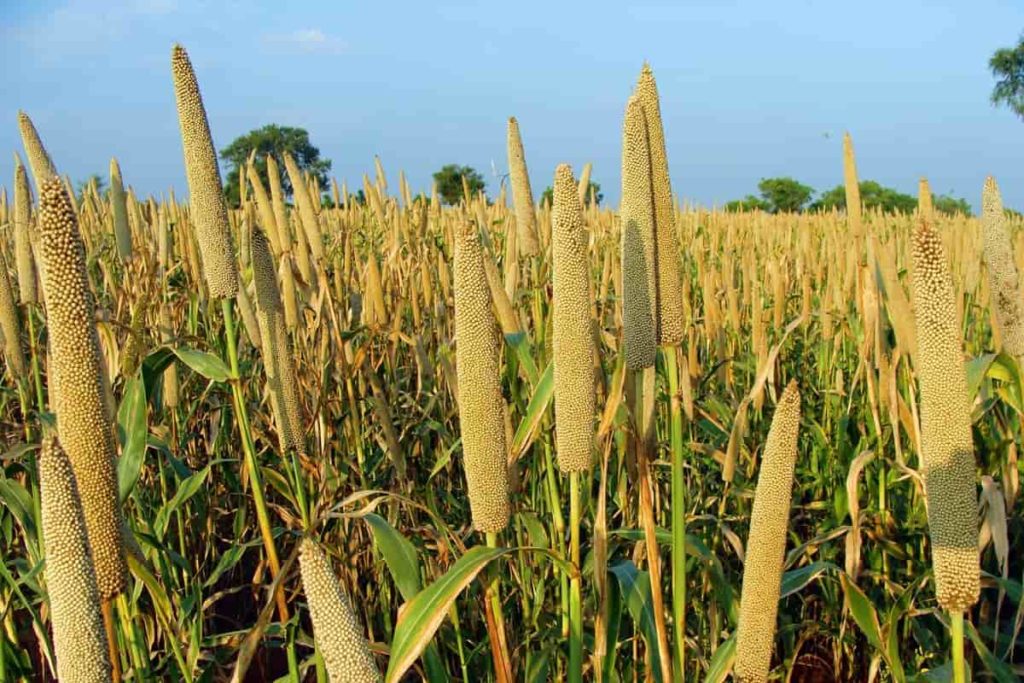
Control measure – At 15-day intervals, apply a foliar spray of 2% DAP 2-3 sprays.
Potassium deficiency symptoms
Deficiency first appears on old leaves. Irregular necrotic patterns are mixed with red pigmentation. Streaked patterns, signs, and margins on the interveinal tissue move toward the base.
Control measure – Apply a foliar spray of KCl by 1%.
Sulfur deficiency symptoms
Sulfur deficiency first appears on younger leaves. The new growth is light yellow.
Control measure – Apply a foliar spray of CaSO4 by 2%.
- How to Make Houseplants Bushy: Effective Tips and Ideas
- Innovative Strategies for Boosting Coconut Pollination and Yield
- Pollination Strategies for Maximum Pumpkin Yield
- The Complete Guide to Chicken Fattening: Strategies for Maximum Growth
- Natural Solutions for Tulip Problems: 100% Effective Remedies for Leaf and Bulb-Related Issues
- Revolutionizing Citrus Preservation: Towards a Healthier, Greener Future
- Natural Solutions for Peony Leaf and Flower Problems: 100% Effective Remedies
- Maximizing Profits with Avocado Contract Farming in India: A Comprehensive Guide
- Natural Solutions for Hydrangea Problems: 100% Effective Remedies for Leaf and Flowers
- The Ultimate Guide to Choosing the Perfect Foliage Friend: Bringing Life Indoors
- From Sunlight to Sustainability: 15 Ways to Use Solar Technology in Agriculture
- The Ultimate Guide to Dong Tao Chicken: Exploring from History to Raising
- The Eco-Friendly Makeover: How to Convert Your Unused Swimming Pool into a Fish Pond
- Mastering the Art of Delaware Chicken Farming: Essentials for Healthy Backyard Flocks
- 20 Best Homemade Fertilizers for Money Plant: DIY Recipes and Application Methods
- How to Craft a Comprehensive Free-Range Chicken Farming Business Plan
- Brighten Your Flock: Raising Easter Egger Chickens for Beauty and Bounty
- How to Optimize Your Poultry Egg Farm Business Plan with These Strategies
- Subsidy for Spirulina Cultivation: How Indian Government Schemes Encouraging Spirulina Farmers
- Ultimate Guide to Raising Dominique Chickens: Breeding, Feeding, Egg-Production, and Care
- Mastering the Art of Raising Jersey Giant Chickens: Care, Feeding, and More
- Ultimate Guide to Raising Legbar Chickens: Breeding, Farming Practices, Diet, Egg-Production
- How to Raise Welsummer Chickens: A Comprehensive Guide for Beginners
- How to Protect Indoor Plants in Winter: A Comprehensive Guide
- Ultimate Guide to Grow Bag Gardening: Tips, Tricks, and Planting Ideas for Urban Gardeners
- Guide to Lotus Cultivation: How to Propagate, Plant, Grow, Care, Cost, and Profit
- Agriculture Drone Subsidy Scheme: Government Kisan Subsidy, License, and How to Apply Online
- Ultimate Guide to Raising Araucana Chickens: Breed Profile, Farming Economics, Diet, and Care
- Bringing Hydroponics to Classroom: Importance, Benefits of Learning for School Students
- Ultimate Guide to Raising Polish Chickens: Breed Profile, Farming Economics, Diet, and Care
- Ultimate Guide to Raising Australorp Chickens: Profile, Farming Economics, Egg Production, Diet, and Care
- Silkie Chicken Farming: Raising Practices, Varieties, Egg Production, Diet, and Care
- Sussex Chicken Farming: Raising Practices, Varieties, Egg Production, Diet and Care
- Homemade Feed Formulations for Livestock: Discover Cost-effective Starter to Finisher Feed Recipes
- 20 Best Pig Weight Gain Supplements: Top Swine Weight Gain Formulas
- Ultimate Guide to Elderberry Farming: Propagation, Planting, Yield, Cost, and Profit